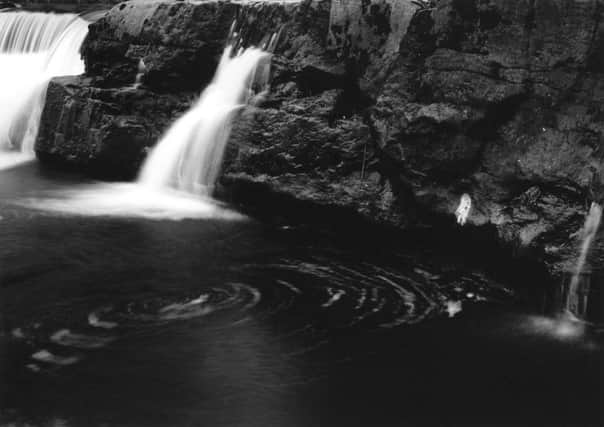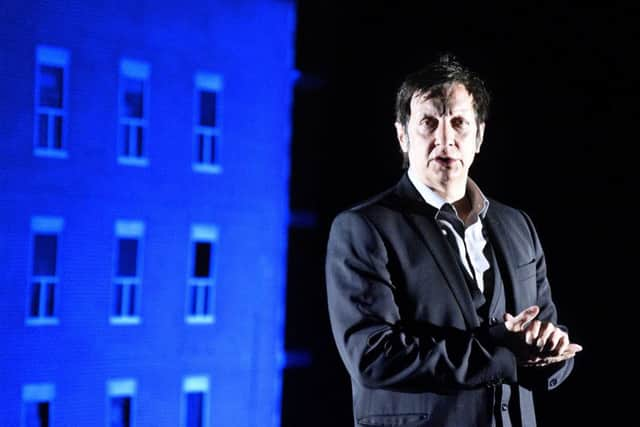Arts review: Thomas Joshua Cooper: Wandering Home


Thomas Joshua Cooper: Wandering Home
Glasgow Cathedral and Govan Old Parish Church
Rating: *****


Who was Old King Cole? Probably Coel Hen, or Old Coel, a king in the Old North – north west England and southern Scotland – in Welsh legend. It was “Old” because Welsh, or Brittonic, was once spoken there in a linguistic territory that linked Scotland and Wales. If he existed at all, Cole’s kingdom could have been one of several. Rheged, for instance, included Cumbria and southwards. Alt Clut, or Dumbarton, later Strathclyde, lay to the north. In the east, the Lothians were named after Loth, king of the Brittonic Votadini or Goddodin who gave their name to Edinburgh. When the Romans took their armies out of Britain, with no military organisation the province was at the mercy of invaders. Not so the kingdoms north of Hadrian’s Wall. They had kept their warrior traditions and for that reason Scotland has remained a distinct entity ever since.
The familiarity of Old King Cole demonstrates how that remote, but formative time is still with us if we do but look. There are other names from then, too, that are as familiar, but about which we are no more curious. Was St Enoch, for instance, ever more than a Glasgow shopping centre, or St Mirren (or Mirrin) more than a Paisley football club? Then what about those whose names we have forgotten altogether, but who helped create the land we live in? Who, for instance, was, St Kessog, before St Andrew patron saint of Scotland, or St Constantine? And who remembers that St Mungo was the same person as St Kentigern?
Advertisement
Hide AdAdvertisement
Hide AdTo give substance to these ancient names and trace the footsteps of these missing saints, Thomas Joshua Cooper is exhibiting work in Glasgow from an ongoing project called Wandering Home, Following the Celtic Peregrinati. The exhibition is split between two ancient sites associated with early saints, Glasgow Cathedral, founded by St Mungo and bearing his name, and Govan Old Parish Church where part of the shrine of St Constantine can still be seen.
Cooper follows the saints in their peregrinations, but his pictures are more subtle and intriguing than any simple narrative would be. Generally of something seen close-to, a stretch of water, rushes, or trees at the edge of a loch, they seem still even when they record waves or moving water. It is as though we are standing with the ancient saint, lost in contemplation perhaps, but living in the moment. Unburdened by the weight of history, the 1,500 years of hindsight with which a lesser artist would have crowded his image, these pictures are as innocent of all that baggage as the pilgrim saint who once stood at the spot the photographer has recorded.
The saints were called “peregrinati,” wanderers, or pilgrims because their lives were lived as a pilgrimage. They went alone into the wilderness, or equipped only with staff and bell among people who were strangers, teaching a new attitude to life itself by the example of their courage and asceticism. Their solitary way was very different indeed from the powerful organisation that the church elsewhere was already becoming. (The Roman Church has always been reluctant to recognise these early radicals.)
By choosing places that were, or might have been significant in their lives, Cooper has made these remote figures seem vividly present to us in spite of all the layers of urban and industrial history that so often overlie the places they frequented. He and his wife Catherine Mooney conceived this project, he says, as a kind of thank you to Glasgow for the 30 years they have lived there. It is we who owe them thanks, however. This work gives us back something that, until it was made imaginatively present as it is in these images, lay beyond the horizons of our collective imagination.
The first of the saints was St Ninian, remembered here in a jagged headland on the Solway. Born in the fourth century, Ninian lived before St Patrick and might also have come from Cumbria as Patrick is reputed to have done. He made his centre at Whithorn where he built a church of stone, the Candida Casa, or White House. It tells us something about him that only the Romans could build in stone. Nor did the other saints build ambitiously. He surely meant his white church to be visible from afar like a spiritual beacon. Certainly he chose a nodal point; you can stand in Scotland and see England, Ireland and the Isle of Man.
Of all the early saints, however, Columba, the Apostle of the Picts is best known. Cooper travelled to his birthplace in Donegal to make a beautiful image of birch trees over Garten Loch. A pilgrim himself, he then followed Columba, looking down into the River Foyle as he might have done on the journey to Scotland, or crossing the sea and reaching Iona. Cooper also records the place on Iona where he died. St Mirrin was one of his companions and founded the monastery that became Paisley Abbey, choosing a site at the junction of the Espedaire Burn and the White Cart Water. Here in a picture of a nearby fall in the river, Cooper has found a fragment of ancient wilderness in a modern urban landscape.
Like Columba, St Mungo too may have preached among the Picts, for Cooper found and recorded St Mungo’s Well, a source of pure water in the hills near Gleneagles then in Pictland. The two saints also met and Cooper records that historic place.
St Mungo’s mother was St Enoch, daughter of King Loth. His father is unknown for she was raped and became pregnant. With the grim vengefulness of modern honour killings, the king ordered that his daughter be flung off a cliff on Traprain Law in East Lothian. Cooper invokes this with a photograph of a steep, dark cliff on the fortified hill’s eastern face. Like the huntsman in Snow White, however, those charged with this grim task could not bear to carry it out. Instead they set the princess adrift in a boat and the tides took her up the Firth of Forth to Culross. (Cooper suggests an analogy with Moses in a picture of rushes by the water’s edge.) At Culross, St Serf who had already established a Christian community gave her shelter. When he grew up St Enoch’s son, christened Kentigern, but called Mungo, or Dear One, was asked by a man called Fergus to take his body to a church founded by St Ninian at Cathures, the Roman fort on the Clyde that preceded Glasgow. In a series of pictures, Cooper suggests how Mungo would have travelled west along the Antonine Wall and then followed the Molendinar Burn down to the Clyde. There he built his church on the banks of the burn and called the place Glas Cu. In the depths of the modern city, Cooper has found a little stretch of water looking as it might have done 1,500 years ago.
Advertisement
Hide AdAdvertisement
Hide AdHe has also followed St Constantine to his place of martyrdom in Kintyre and St Kessog to Loch Lomond, where he founded a monastery on the Isle of Inchtavannach. His picture there is of trees and rocks with a misty view across the loch. He always works in black and white, but apart from one reference to colour, this picture seems closely to match the words of a Gaelic poet writing more than 1,000 years ago and so near enough to the time of the saints themselves to reflect their sensitivity to nature just as it also matches the artist’s own: “The harp of the woods plays melody, its music brings perfect peace: colour has settled on every hill, haze on the lake of full water.”
• Until 30 September. The exhibition is part of Our Place in Time, events in association with the meeting in Glasgow of the European Association of Archaeologists, www.ourplaceintimeartsfestival.com